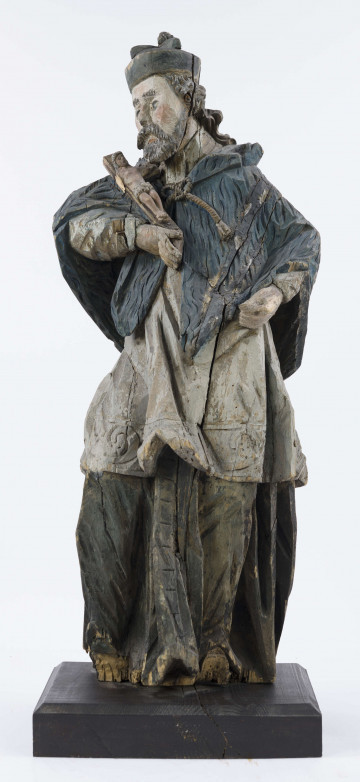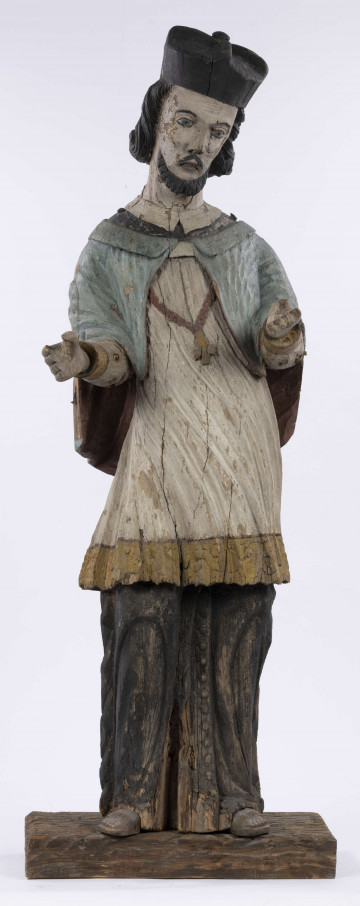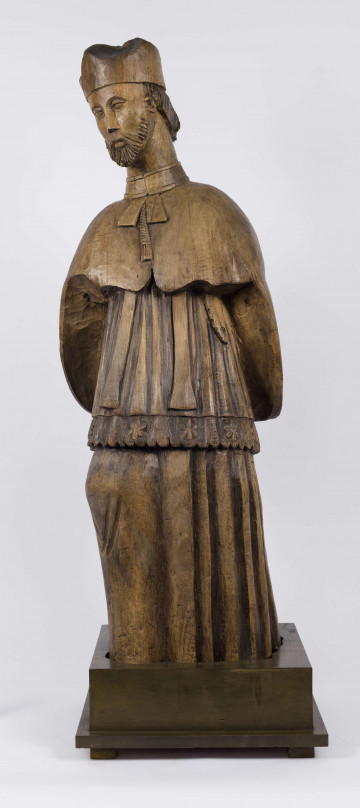
Saint John of Nepomuk
1801 — 1900
National Museum in Lublin
Part of the collection: Folk Art of the Lublin Region (17th–1st half of the 20th c.)
Many sculptural representations of patron saints can be found in small village churches, roadside chapels (see E/8062/ML), or independent figures placed only on a pedestal without a roof (see E/6353/ML). They include the figure of St John of Nepomuk, popular throughout Poland as a patron of bridges and dikes, a protector during floods and an advocate of the drowning. Sculptures with his image were usually found on chapels erected on river banks and at shallows allowing swimming across them. There were also statues on baulks, whose function was to protect crops from hail and drought.
The cult of the Saint spread in Poland at the turn of the 17th and 18th centuries. The figures are still commonly called Nepomuks. It might have been influenced by the alleged place of the Saint's birth. It is said to have been the village of Pomuk, which after merging with neighbouring Přesanice, took the name Nepomuk. John of Nepomuk (about 1350-1393) was a canon in Bohemian Prague. There are different versions of the reasons for his martyrdom. The most famous one says that during the conflict between King Władysław IV of Luxemburg and the Archbishop of Prague, John of Nepomuk fell into disgrace as he did not want to tell the King the secret of the confession of his wife Sophie of Bavaria. He was imprisoned, tortured by puncturing, his body was burnt, and finally, he was thrown off Charles Bridge into the Vltava River, where he drowned. Due to his silence, he also became the patron saint of confessors and sincere confession.
The sculptures, often following the Baroque tradition in counterpoint, depict the Saint in priestly attire: a cassock, a short white surplice, a stole, a cape on his shoulders and a biretta on his head. He holds a cross in his right hand, and in his left, he has a palm leaf symbolising martyrdom. In some images, he holds a finger at his mouth as a gesture of secrecy. There is often a circular halo of five stars around the head. Additional attributes may be a key, a book, a letter, a padlock, a seal or a bridge.
Author / creator
Dimensions
cały obiekt: height: 128 cm
Object type
sculpture
Technique
polychromy
Material
wood, paint
Creation time / dating
Creation / finding place
Owner
The National Museum in Lublin
Identification number
Location / status

1801 — 1900
National Museum in Lublin

1890 — 1910
National Museum in Lublin

1890 — 1910
National Museum in Lublin
DISCOVER this TOPIC
Castle Museum in Łańcut
DISCOVER this PATH
Educational path